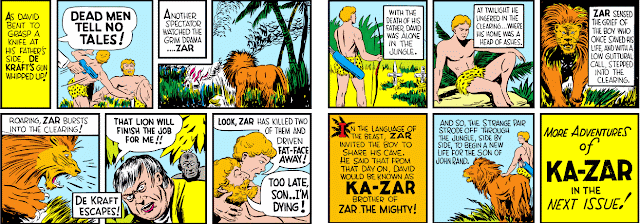
Following the 1972 introduction of William Burnside, the mentally unstable
Captain America of the 1950s--and his subsequent fall from grace at having to be brought down by the Captain America he idolized--there seemed to be no hope for recovery for this man whose good intentions at filling the shoes of his wartime hero were tragically undone by his twisted vision of what America, and what the ideal American, should be. Almost immediately intercepted by the villainous
Dr. Faustus after being taken into custody, "Cap" was thereafter conditioned into assuming a new identity as
the Grand Director, the figurehead of a white supremacist organization called the National Force; but when Faustus was confronted by the real Cap, the Director made a drastic choice when Faustus insisted he attack his namesake, and instead activated a device on his person which incinerated him.
As for Jack Monroe, Burnside's young sidekick, "Bucky"--who came clean with the real Captain America and went on to assume Cap's discarded identity as the Nomad--he would later meet his death at the hands of James Barnes, the
original Bucky, who had been conscripted by the Russians as the assassin known as
the Winter Soldier but who was later freed of his mental enslavement and in time took on the identity of Captain America, at Cap's behest. As we'll discover, that irony will not be lost on one of the principal characters of the story the PPC spotlights today.
And that story begins nearly thirty years later (our time), as S.H.I.E.L.D. agent Sharon Carter, who herself had been manipulated by Faustus into killing Captain America following the events of Civil War, has infiltrated the lair of Faustus and his associates, the Red Skull and Arnim Zola, where she discovers someone who appears to be Steve Rogers--a man she knows to be dead by her own hand. Yet when she investigates further, she confirms the identity of this man:
another "Captain America" who should be dead, and, given his appearance, has her recalling his fate as part of the National Force.
A slight error on writer Ed Brubaker's part--in the earlier story, scripter Michael Fleisher made it clear that the Director took his own life as opposed to any prompting from Faustus (though it could be argued that Faustus's manipulative handling of Burnside "made" him take such a step to break free of his conditioning). But though Sharon isn't privy to how Burnside survived, nor what has affected his memory, she means to see to it that his involvement in this plot, whether consensual or not, ends now.
Some of you will recognize Aleksander Lukin, who played a key part in bringing the Soldier out of stasis to further a plot to gain the Cosmic Cube; and if so, you also know of his relationship with (or, rather, "connection" to) the Skull, who will also play a part in this drama.
Faustus, as it turns out, not only still has his hooks in Burnside, but also in Sharon--though it's his expertise involving the former character which holds interest for the Skull and Zola.



















































